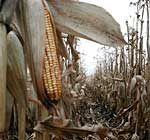Ethanol business is bright spot
By Mark Steil
Minnesota Public Radio
November 9, 2001
|
| RealAudio |
Minnesota farmers are harvesting a crop which is not worth much money at the local elevator. This is the fourth straight year of poor prices for cash crops like corn and soybeans. Some farmers, though, are getting better prices than others. Farmers who belong to ethanol cooperatives are actually making a profit.
| |
|
|
|
||
It's become a yearly ritual for southern Minnesota corn farmers. They spend weeks harvesting mountains of corn, and months searching for ways to sell it. Generally, that means using government subsidy programs to get a few more dollars for their corn.
Southwest Minnesota farmer Stan Lohrenz is familiar with the paper shuffle. He's driving a green combine through a brown corn field, and hoping for better prices.
"We always hope that things will turn around, and we'll see some price increase. I guess we'll have to wait and see what happens. Definitely makes it a challenging occupation," says Lohrenz.
One challenge paid off. Lohrenz invested in a plant in nearby Bingham Lake that makes corn-based ethanol.
Ethanol is 200 proof alcohol. It's mixed with gasoline and used as fuel. As part of his investment, Lohrenz pledged to deliver about 20 percent of his corn crop per year to the plant. In return, he shares in the plant's profits, and that helps double the price he gets for the corn.
"Any time we can get bottom line of $3 per bushel for our corn, we can make some money," says Lohrenz.
Make some money - and change the way he thinks about farming.
"I guess our philosophy has been - with the ethanol plant - we're not any longer in the food business or the feed business, but now we're in the energy business," Lohrenz says.
But it's a business full of controversy.
Critics say it takes more energy to produce ethanol than the fuel contains. Supporters say that's not true, citing studies showing ethanol yields 25 percent more energy than it consumes.
| |
|
|
|
||
Critics question government subsidies for ethanol, while supporters call them a sound investment in a home-grown fuel.
To the managers of the Bingham Lake ethanol plant, the future of the alternate fuel is bright. They've doubled production in the last year. They're finding extra profit in ethanol byproducts. There's carbon dioxide from the fermenting process which is sold to soft drink companies. And there's a sweet-smelling feed sold to livestock farmers.
"Guys used to use barley, a lot of soymeal. They can use this now, and the cattle love it," says Dan Kelly, one of the managers of the plant.
One side of the building is all industrial roar and miles of pipes. The other side is corporate - background music plays, while workers monitor computers controlling the production cycle.
Midwest refineries buy the ethanol and blend it with gasoline to help the fuel burn cleaner. Farmer Herb Friesen, a member of the co-op's board of directors, says ethanol production is a blend.
"We have taken the investment of the farmer, and partnered with people who have the expertise of engineering a plant and operating a plant profitably," says Friesen.
There was a major development this year boosting the future of ethanol. The Federal Environmental Protection Agency refused to grant a waiver request from California officials, who wanted permission to use fuel additives other than ethanol in their gas. Many believe the EPA decision means California will become a major buyer of midwest ethanol.
For farmer Stan Lohrenz that's good news, because it means a growing demand for corn. And it's good news for his neighbors, since the ethanol plant needs more corn than its members supply. Lohrenz says it buys that corn on the open market, boosting local prices.
"We feel that the ethanol plant probably has increased the value of the corn crop in this area probably by 5 cents to 10 cents per bushel," Lohrenz says.
That could mean several thousand dollars to an average-sized farm. And some years, that can be the difference between profit and loss.
More from MPR

